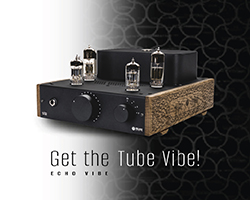At £1250 with the standard cable or £1350 with the Premium cable, the Mr Speakers Ether C headphones certainly fall into the high-end price bracket, but will they deliver on sound quality? Janine Elliot finds our for Hifi Pig.
I’ve been listening to new ground-breaking headphones since, well, Sennheiser 414s. Every time the intention was that they were better than the one before, otherwise there would be no point. All I had heard before these were closed back, heavy and tight fitting ‘head vices’ that had bass, middle and no definition for my young 20kHz ears to benefit from. Whether Koss, Dynatron, Binatone or Winthrop, none of them actually sounded right for me. Indeed, until the 1980’s the BBC regularly issued Bakelite headphones to sound engineers, which really worried me. Whilst Koss did actually change the opinion of headphones as purveyors of good music, the good ones like Pro4AA were 250 ohms and heavy so you needed to sit tied down to the side of your hifi stack, and probably swaying about on a rocking chair wearing slippers. Then of course we all went portable with walkmans, CD players and mp3 players with horrible sounding IEMs. Now that at last we are starting to listen again with decent DAPs, such as Astell and Kern and Audio Research, we need to piggybank head-amps, because the new range of exciting headphones from Oppo, Audeze, Abyss, etc, are so inefficient the players’ built-in amplifiers can’t cope. For that reason, my own choice for mulling about the house or lying in my bed is my Audio Technica W1000X which give me a reasonable listening level from my Fiio X5 without being tied down to a mains socket or weighed down with a separate portable amp.
The new Ether C from American company Mr Speakers, designed and manufactured by a small team led by Dan Clark are closed-back, like my AT’s, and ~4dB less efficient than their open-back variety, meaning a separate amplifier is mandatory. Both use the same technology of V-Planer diaphragm, which has very much to do with the low output from these and most planar headphones. Let me explain; instead of a single driver pushing in and out a light-weight diaphragm as in traditionally headphones in the past, a planar (or in this case a V-Planar) designs means that a whole flat panel has to move now. It needs more oomph to do it. So, expecting your 40mW amp to do this is like pulling a caravan with a moped. This inefficiency is a small price to pay when you consider the better sound that can be available.
Their distinctive but traditional looking opened back design called the Ether (also being reviewed on Hifi Pig soon) was Mr Speakers’ first 100% made and designed headphones. The closed-back and designated “C” version of the Ether has unusually shaped ear-cups made from carbon-fibre. I am told most people liked this, but for ear-speakers around £1250 I wanted to see something more exotic, but I guess encrusting it in thousands of diamonds might make it too expensive, and heavy. Mr Speakers want you to see the carbon-fibre, though don’t want you to know about a secret element in its design which Mark Dolbear from Electromod, who supplied the review sample, couldn’t or wouldn’t tell me.
The shape of the carbon-fibre body is so that there are no standing waves to colour the sound. Going with Carbon fibre was not just for weight and shape but also for its sonic performance of not storing energy. It reminded me of the Flare R2 IEMs I reviewed a while ago; using the same driver and altering the metal it was housed in really did make a change in the sound, whether aluminium, stainless steel or titanium.
Played directly from my portable player was never going to be an option, so I reviewed this model with several similarly priced transistor and tube headphone amps; the Earmax/Brockseiper, Graham Slee Solo and Voyager, and the Schiit Lyr 2 with the Lisst solid-state valves. The Earmax just couldn’t cope, distorting like mad, so I switched that one off. The Slee offerings worked well, but the Schiit Lyr 2 with the metal encased Lisst was like a breath of fresh air, giving a very clear and exciting sound which aided my listening of these cans, over the valves which gave a more rounded off top end. I reviewed the Lyr 2 a while back and loved it then. This one was even better, especially with the Lisst. The sound improved the more I played, proving that running in is very important. Where the sound lacked bass and detail at the start, after 100 or more hours it all began to open up and sound quite natural to me, on whatever type of music I used, adding bass and top end detail the more I listened.
The Mr Speakers are unlike most headphones. Usually you just put them on and the sound you hear is very quickly what you expect to get for the rest of their life. With these cans, the run-in time is a minimum of around 40-60 hours, which actually isn’t long if you just leave it playing when you’re asleep. Much has to do with the V-Planers. Dan felt that a flat planar isn’t rigid enough, but with the corrugated (or pleated as Dan calls it) diaphragm measuring 2.75” by 1.75″ it makes it faster and reduces distortion and extend the frequency range. Whilst the Ether weighs in at 375g the “C” adds another 17g (or 0.6oz), neither giving me any sense of overweight. Indeed the Ethers are the first cans with a headband made of NiTinol “memory metal” (Nickel Titanium) which being very light and elastic means you can fit these headphones nicely on any shaped head. I did feel they were comfortable for long periods of time, though the Audio Technica 3D-wing support headbands are still my favourite. Measuring at around 23ohms, these headphones should be fairly loud, and I do worry that when we are using 2 Watt power-amps to drive our cans we need to be as careful about looking after our ears as we tell our kids with their IEMs.
My first venture was to wake these beauties up with the celebrated complete Queen Studio Collection vinyl re-release which showed these iconic recordings to their full, with punchy bass and oomph galore. No problems there. These could handle anything from Freddie, John, Roger or Brian. At the other extreme turning to Ray LaMontagne The Sun Turns Back “Be here Now” showed off the openness and spacious recording with the heavy reverb in the piano contrasting very well with the close mic’d acoustic guitar. Ray’s breathy voice filled the void between my ears in a way that made me really love what I heard, with a speed that allowed hidden voices behind the digital reverb to come out quite eerily. Where some of that detail wasn’t in the Schiit Lyr2 valves, the Lisst ICs woke up the sound giving more speed and authority. These were made for each other. This came as no surprise; the designer knows the company very well so it is no wonder they are tuned for each other. Indeed, the development name for the Ether was “Dreadnaught” as homage to Mike Moffat from Schiit, who used to work for Theta that made a curvy-fronted multichannel theatre amplifier with the same name, and which Dan, the designer of the Mr Speakers, still uses to this day. His website even sells Schiit products. And a 3D printer.
Whilst I liked all I heard, it still left me feeling that I was hearing between my ears rather than in front, despite the angled drivers, but what made these so good was the fact that I could play just about any music with them, whereas many headphones have their favourite music styles. Once you get accustomed to the lower efficiency (and Dan believes the more efficient the headphone the more you will hear the background noise, so the less efficient the less noise) and pump up the volume you really do start to make the most from the headphones. There is quite a big difference in sound between the Ether and Ether C, which Dan is pleased about; there would be very little point in creating to identical sounding cans, leaving aside the matter of sealing or not of outside sounds. No, these are two quite different headphones. The Ether has a more open soundstage, but the “C” has a better bass end, especially once you pump up the volume. Playing the big bass thuds at the start of Sting “A Perfect Day” track 1 sounded good at high volume but less apparent at lower. Those fundamental frequencies are very clear and give an authority that provide these headphones with an edge over the Ether, I found. The mid-range was also highly inviting and made listening fun, but not sticking out at all, if that makes sense. The infamous 1960 Chicago Symphony Orchestra performance of Pines of Rome (Respighi), gave an infinite set of tones and three dimensions of sound in my head, the work aptly described as a tone poem.
Talking of tone, the Ether C comes complete with two black and a white pads to tailor the sound to your requirements, a manually adjusted EQ control that took me by surprise; being used to keeping the grilles off my loudspeakers for 40 years. I used 1 black insert; two gives a better bass, or should I say less top. The white insert is for the most ‘top loss’, all four combinations allowing up to around 4dB adjustment in total at around 5HZ plus, or more if decide to install all the pads, which I certainly wouldn’t recommend! The sound was already quiet, so adding padding to get rid of the top to make the bass louder just seems like a backward philosophy to me. It’s a bit like putting lorry wheels on a mini to make it go faster. No, tackle the problem with the engine. My C’s were provided with the basic cable, which I found very noisy in my listening test; every time I tapped or touched it, it could be heard. As soon as I listened to the more expensive Premier cable, adding another £100, that cable sheath noise wasn’t there and the sound was much improved in definition and speed, and provided a better bass and treble extension. Indeed, the fact that it was closed back seemed to almost disappear, giving a very open sound, rather than feeling I was stuffed in an under-stairs cupboard. Where the sound with the basic cable left me feeling that I was still hearing between my ears rather than in front, despite the angled drivers, the Premiers opened up that soundstage leaving me to wonder whether they were indeed closed back at times. I must add, however, that it is not the most ‘open’ closed headphones I have listened to, and I wonder if that is an area Dan should work at for his next offering.
Where these headphones make their mark, though, is in the fact that they worked well with anything I played, from Bowie to Beethoven, Eagles to Ellington. As someone who likes a wide range of music and instruments, this headphone never felt wanting whatever I played it; working very precisely with Sitar and powerfully with cathedral organ. I did find, however, that it was perhaps being a trifle politically correct, never giving me a sense that it was excited about anything. Sound was all there, but I really felt I couldn’t get deep enough into the music as I hoped £1,250 would get me. This is not a criticism, some headphones just can’t cope with certain types or music at all and these really did well, whatever I played. I just want to hear every nuance of sound and not want to take them off my head. There was, of course, much difference in sound between all four head amps I tried, but with the Schiit plus Lisst solid-state tubes they were pretty damn good, and the best for me.
CONCLUSION
This is an excellent all-round performer, superbly built and able to play well anything I put before it. Mated with a decent head-amp it performs with excellent bass and warm mid band, and big step up from the Alpha Prime, their previous top closed back model. Where usually only open-backed headphones give you that big open soundstage, these closed-back ‘cans’ can do almost the same, and cut out much of the noises outside. The two Ethers do sound different, so listen to both, preferably with the Premier upgraded cable, before you buy!
Value for Money – 8.4/10
Build Quality – 8.6/10
Overall – 8.48/10
Price: £1250 with standard cable and £1350 with Premium cable.
Pros:
Work on all music
Can EQ to your choice of sound
Detail of sound
Single price for ¼”, mini-jack or 4 pin XLR cable connections.
Cut out a fair amount of external background noise
Lamb-leather ear-pads
Box it comes in
Headphone case, which also works as a headphone stand!
Cons:
Pretty expensive
I personally don’t like the shape of the carbon fibre
I don’t like the idea of pads to EQ the sound.
You need to be patient for 40-60 hours and then really enjoy them!
Janine Elliot







































































































































































































You must be logged in to leave a reply.